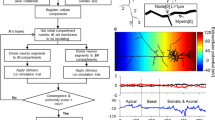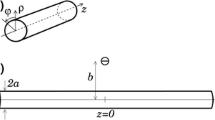Abstract
Electrode designs and strategies for electroneurogram recordings are often tested first by computer simulations and then by animal models, but they are rarely implanted for long-term evaluation in humans. The models show that the amplitude of the potential at the surface of an axon is higher in front of the nodes of Ranvier than at the internodes; however, this has not been investigated through in vivo measurements. An original experimental method is presented to emulate a single fiber action potential in an infinite conductive volume, allowing the potential of an axon to be recorded at both the nodes of Ranvier and the internodes, for a wide range of electrode-to-fiber radial distances. The paper particularly investigates the differences in the action potential amplitude along the longitudinal axis of an axon. At a short radial distance, the action potential amplitude measured in front of a node of Ranvier is two times larger than in the middle of two nodes. Moreover, farther from the phantom axon, the measured action potential amplitude is almost constant along the longitudinal axis. The results of this new method confirm the computer simulations, with a correlation of 97.6 %.








Similar content being viewed by others
References
Andreasen LNS, Struijk JJ, Haugland MK (1997) An artificial nerve fiber for evaluation of nerve cuff electrodes. In: Proceedings of the 19th annual international conference of the IEEE engineering in medicine and biology society, 1997, vol 5, pp 1997–1999
Andreasen LNS, Struijk JJ, Lawrence SM (2000) Measurement of the performance of nerve cuff electrodes for recording. Med Biol Eng Comput 38:447–453
Andreasen LNS, Struijk JJ (2002) Signal strength versus cuff length in nerve cuff electrode recordings. IEEE Trans Biomed Eng 49:1045–1050
Brian W, Durand DM (2011) Selective recovery of fascicular activity in peripheral nerves. J Neural Eng 8:056005
Cavallaro E, Micera S, Dario P, Jensen W, Sinkjaer T (2003) On the intersubject generalization ability in extracting kinematic information from afferent nervous signals. IEEE Trans Biomed Eng 50:1063–1073
Clark JW (2009) The origin of biopotentials. In: Webster JG (ed) Medical instrumentation, application and design ch. 4. Wileyfourth ed. Wiley, New York, pp 126–188
Clark J, Plonsey R (1968) The extracellular potential field of the single active nerve fiber in a volume conductor. Biophys J 8:842–864
De Luca CJ, Hostage EC (2010) Relationship between firing rate and recruitment threshold of motoneurons in voluntary isometric contractions. J Neurophysiol 104:1034–1046
Dhillon GS, Horch KW (2005) Direct neural sensory feedback and control of a prosthetic arm. IEEE Trans Neural Syst Rehabil Eng 13:468–472
Djilas M, Azevedo Coste C, Guiraud D, Yoshida K (2009) Interpretation of muscle spindle afferent nerve response to passive muscle stretch recorded with thin-film longitudinal intrafascicular electrodes. IEEE TNSRE 17:445–453
Djilas M, Azevedo-Coste C, Guiraud D, Yoshida K (2010) Spike sorting of muscle spindle afferent nerve activity recorded with thin-film intrafascicular electrodes. Intell Neurosci 2010:9:1–9:10
Ganapathy N, Clark JW (1987) Extracellular currents and potentials of the active myelinated nerve fiber. Biophys J 52:749–761
Huigen E, Peper A, Grimbergen CA (2002) Investigation into the origin of the noise of surface electrodes. Med Biol Eng Comput 40:332–338
Liu X, Demosthenous A, Donaldson N (2008) Platinum electrode noise in the ENG spectrum. Med Biol Eng Comput 46:997–1003
Loeb GE, Marks WB, Beatty PG (1977) Electrode arrays intended for chronic, multiple single-unit recording from captured nerve fibres. Med Biol Eng Comput 15:195–201
McIntyre CC, Richardson AG, Grill WM (2002) Modeling the excitability of mammalian nerve fibers: influence of afterpotentials on the recovery cycle. J Neurophysiol 87:995–1006
Meier JH, Rutten WLC, Boom HBK (1998) Extracellular potentials from active myelinated fibers inside insulated and noninsulated peripheral nerve. IEEE Trans Biomed Eng 45:1146–1153
Navarro X, Krueger TB, Lago N, Micera S, Stieglitz Thomas, Dario Paolo (2005) A critical review of interfaces with the peripheral nervous system for the control of neuroprostheses and hybrid bionic systems. J Peripher Nerv Syst 10:229–258
Nielsen TN, Sevcencu C, Struijk JJ (2014) Comparison of mono-, bi-, and tripolar configurations for stimulation and recording with an interfascicular interface. IEEE Trans Neural Syst Rehabil Eng 22:88–95
Popovic DB, Stein RB, Jovanovic KL, Dai R, Kostov A, Armstrong WW (1993) Sensory nerve recording for closed-loop control to restore motor functions. IEEE Trans Biomed Eng 40:1024–1031
Qiao S, Odoemene O, Yoshida K (2012) Determination of electrode to nerve fiber distance and nerve conduction velocity through spectral analysis of the extracellular action potentials recorded from earthworm giant fibers. Med Biol Eng Comput 50:867–875
Qiao S, Yoshida K (2013) Influence of unit distance and conduction velocity on the spectra of extracellular action potentials recorded with intrafascicular electrodes. Med Eng Phys 35:116–124
Rolston JD, Gross RE, Potter SM (2009) A low-cost multielectrode system for data acquisition enabling real-time closed-loop processing with rapid recovery from stimulation artifacts. Front Neuroeng 2(12):1–17
Rossel O, Soulier F, Bernard S, Cathebras G (2011) Sensitivity of a frequency-selective electrode based on spatial spectral properties of the extracellular AP of myelinated nerve fibers. In: Annual international conference of the IEEE engineering in medicine and biology society (EMBC 2011) pp 5843–5846
Rossel O, Soulier F, Cathebras G (2009) New electrode layout for internal selectivity of nerves. In: Annual international conference of the IEEE engineering in medicine and biology society, 2009 (EMBC 2009), pp 3798–3801
Rossel O, Soulier F, Coulombe J, Bernard S, Cathebras G (2011) Fascicle-selective multi-contact cuff electrode. In: Annual international conference of the IEEE engineering in medicine and biology society (EMBC 2011) pp 2989–2992
Rossini PM, Micera S, Benvenuto A et al (2010) Double nerve intraneural interface implant on a human amputee for robotic hand control. Clin Neurophysiol 121:777–783
Rutten WLC, Frieswijk TA, Smit JPA, Rozijn TH, Meier JH (1995) 3D neuro-electronic interface devices for neuromuscular control: design studies and realisation steps. Biosens Bioelectron 10:141–153
Schuettler M, Donaldson N, Seetohul V, Taylor J (2013) Fibre-selective recording from the peripheral nerves of frogs using a multi-electrode cuff. J Neural Eng 10:036016
Strange KD, Hoffer JA (1999) Restoration of use of paralyzed limb muscles using sensory nerve signals for state control of FES-assisted walking. IEEE Trans Rehabil Eng 7:289–300
Struijk JJ, Haugland MK, Thomsen M (1996) Fascicle selective recording with a nerve cuff electrode. In: Proceedings of the 18th annual international conference of the IEEE engineering in medicine and biology society, 1996. Bridging disciplines for biomedicine, vol 1, pp 361–362
Struijk JJ (1997) On the spectrum of nerve cuff electrode recordings. In: Proceedings of the 19th annual international conference of the IEEE engineering in medicine and biology society, 1997, vol 5, pp 2006–2007
Struijk JJ (1997) The extracellular potential of a myelinated nerve fiber in an unbounded medium and in nerve cuff models. Biophys J 72:2457–2469
Taylor J, Donaldson N, Winter J (2004) Multiple-electrode nerve cuffs for low-velocity and velocity-selective neural recording. Med Biol Eng Comput 42:634–643
Taylor J, Schuettler M, Clarke C, Donaldson N (2012) The theory of velocity selective neural recording: a study based on simulation. Med Biol Eng Comput 50:309–318
Wodlinger B, Durand DM (2009) Localization and recovery of peripheral neural sources with beamforming algorithms. IEEE Trans Neural Syst Rehabil Eng 17:461–468
Yang Z, Zhao Q, Keefer E, Liu W (2009) Noise characterization, modeling, and reduction for in vivo neural recording. In: Bengio Y, Schuurmans D, Lafferty J, Williams CKI, Culotta A (eds) Advances in neural information processing systems, vol 22. MIT Press, Cambridge, pp 2160–2168
Yoo PB, Durand DM (2005) Selective recording of the canine hypoglossal nerve using a multicontact flat interface nerve electrode. IEEE Trans Biomed Eng 52:1461–1469
Yoshida K, Horch KW (1996) Closed-loop control of ankle position using muscle afferent feedback with functional neuromuscular stimulation. IEEE Trans Biomed Eng 43:167–176
Zariffa J, Nagai MK, Daskalakis ZJ, Popovic MR (2009) Influence of the number and location of recording contacts on the selectivity of a nerve cuff electrode. IEEE Trans Neural Syst Rehabil Eng 17:420–427
Zariffa J, Nagai MK, Schuettler M, Stieglitz T, Daskalakis ZJ, Popovic MR (2011) Use of an experimentally derived leadfield in the peripheral nerve pathway discrimination problem. IEEE Trans Neural Syst Rehabil Eng 19:147–156
Acknowledgments
This work was supported by the AXA Research Foundation.
Author information
Authors and Affiliations
Corresponding author
Rights and permissions
About this article
Cite this article
Rossel, O., Soulier, F., Bernard, S. et al. A phantom axon setup for validating models of action potential recordings. Med Biol Eng Comput 54, 1257–1267 (2016). https://doi.org/10.1007/s11517-016-1463-3
Received:
Accepted:
Published:
Issue Date:
DOI: https://doi.org/10.1007/s11517-016-1463-3




